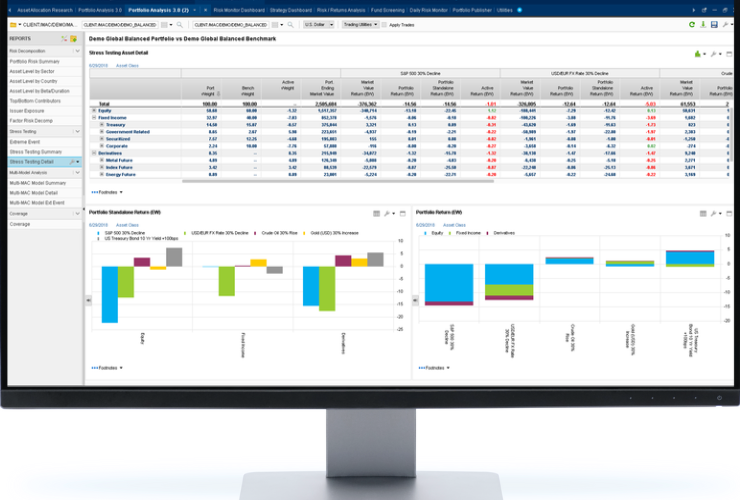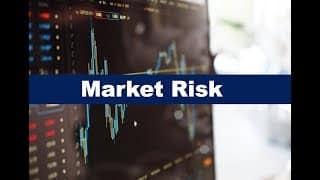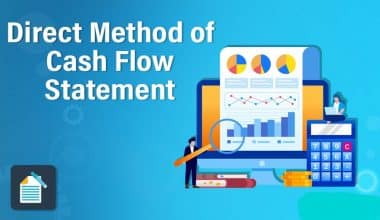First-order sensitivities to interest rates, inflation, credit spreads, currency, and other variables are included in the portfolio analytics and sensitivity data offering, as well as fixed income analytics such as duration (effective and modified) yield. The multi-asset class solution can incorporate data. So, to help you understand more about portfolio analytics, software, and job description we have developed this post to address all that.
Portfolio Analytics
Portfolio Analytics provides the tools and data you need to effectively explain your investment hence, narrative to prospects, clients, and your own management team, with fundamental and statistical versions for the nation, region, and global models, at multiple time horizons. Similarly, you may isolate and analyze sources of risk and return, assess your exposure to factors, dive down to discover the primary contributors to risk and returns, and generate print-ready reports with the product’s risk, performance, and attribution features.
Portfolio Analyst Job Description
Portfolio management, trading, portfolio analytics, risk, compliance, and legal departments are all layers of the investment team at most buy-side businesses. More so, each layer is required to guarantee that a portfolio is maintained in accordance with fiduciary and client rules. Many layers of teamwork with a portfolio analyst.
#1. Tasks and Education
Portfolio analysis is a time-consuming and comprehensive profession that necessitates a strong financial background gained via previous experience and study. Although the most frequent educational prerequisite is a bachelor’s degree in finance, economics, or accounting, many portfolio analysts have postgraduate degrees.
Portfolio analysts have a wide range of responsibilities depending on the company. Despite the variations, portfolio analysts do a number of similar tasks, such as conducting extensive portfolio analysis and providing reports. A comparison of diverse industries, historical trends, and a grasp of financial metrics and regulatory/legal limits that may affect the portfolio are all part of the portfolio study. Furthermore, individual securities or asset allocations are routinely attributed to portfolio performance by portfolio analysts using specialized software packages. Portfolio analysts may also meet with clients and relay portfolio information and client requirements to managers. Therefore, portfolio analysts frequently advance to become portfolio managers or other members of the investment team responsible for making investment choices.
#2. Compensation
Portfolio analysts typically earn between $47,000 and $94,000 per year, with a median pay of $66,204. (according to Glassdoor). Furthermore, the average incentive compensation (year bonus) is $10,044, bringing the median total income to $76,248. (as of Oct. 2023). 1
Total remuneration for portfolio analysts varies greatly depending on years of experience and the type of business, and it is frequently split between annual salary and incentive compensation.
Furthermore, the level of compensation is influenced by the location. Portfolio analysts in the New York metropolitan area, for example, can earn up to 27% more than the national average. 2 Finally, portfolio analysts are compensated higher than their counterparts. The average Portfolio Analyst compensation is 24% higher than the national yearly median earnings ($53,490 as of May 2019), indicating that these positions are generally well compensated.
Using Portfolio Analytics to Identify Risk
Risk assessments used to be limited to a single parameter, such as the borrower’s credit risk. Now it’s evident that traditional financial risk is only one half of the equation, and that other aspects, such as social and environmental hazards, must also be considered.
In the agriculture industry, for example, a water risk assessment must consider more than a borrower’s risk profile. Physical water shortage, a lack of access to water rights, or pumping limits imposed by rules such as the SGMA may limit their options. Financial professionals must be able to examine all of these elements effectively and efficiently utilizing contemporary portfolio analytics in order to properly determine their water risk.
Portfolio analytics software
Do you have a lot of different investments? In fact do your 401(k) plans, trading accounts, and savings accounts all belong to various financial institutions? If that’s the case, you’ll almost certainly get separate notifications on the status of each account, which can be confusing. It’s also difficult to tell where you are in terms of your net worth.
To assist alleviate this difficulty, some investors swear by portfolio analytics software. Dealing with this type of software might be simple in some circumstances, such as for individual investors. Below we provide synopses of portfolio analytics software programs for retail investors as well as much more advanced portfolio analytics software programs for money managers.
#1. Quicken
Price: $149
This system is best suited for those working on a desktop computer. For example, key features for Quicken Premier 2015:
- Multiple Portfolio Views: asset allocations, geographic regions, sectors, performance comparisons
- Insights for improvement
- Import transaction capability from banks and brokerage accounts
- Cost basis tracking
- Capital gains estimates
- Performance vs. market
- Mutual fund comparisons
- Helps make buy/sell decisions
Mobile features include:
- Check account balances
- Track budget
- Updates and alerts
- Snap and store receipt
#2. Owl Software’s
Price: $69. Comes with a free 30-day trial. If you don’t like the program, you can uninstall prior to 30 days to avoid being charged.
Key Features:
- Can track up to 999 portfolios
- Retirement planning
- Brokerage accounts
- College funds
- “What if” analysis
- Capital gains/loss calculations
- Technical analysis stochastics, RSI, trend analysis, moving averages
#3. Quant IX Software’s
Price: $79 per year with technical help, or $109 per year with hence, a Quote Media data feed for fundamental and descriptive data on stocks, ETFs, and mutual funds.
Since 1985, investors have relied on this software, which was created by expert money managers. Consequently, most people consider it to be the ultimate instrument for simple consolidation. Also, with its Portfolio Setup Wizard, you can quickly import your transaction history and balances.
You will also receive transaction accounting for:
- Stock purchases
- Stock sales
- Dividends
- Interest
- DRIPs
- Short sales
#4. Fund Manager
$1292 for the Personal Version (new).
$295 for the Pro Version (new).
$1,495 for the Advisor Version (new).
Retail investors, money managers, and active traders thus, will benefit the most from this portfolio analytics software. It keeps track of all transactions and generates both a Portfolio Active Summary and a Portfolio Performance Summary. (See How Financial Advisors Can Adjust to Robo-Advisors for more information.)
The Portfolio Active Summary includes:
- Beginning market value
- Contributions
- Withdrawals
- Withdrawal distributions
- Account fees paid
- Gain/loss
- Ending market value
The Portfolio Performance Summary includes performance for the following time frames: quarterly, year-to-date, one year, three years, five years, and ten years, in addition to an Index Performance Summary.
Other notable characteristics include:
- Importing capability
- Updates and alerts
- Graphing
- Portfolio comparisons
- Export capital gains information to tax software
- Customizable reports
- Multi-currency support
- 45 graph types
- 21 report types
#5. softTarget’s Balance
Monthly cost: $8,000
If you’re unfamiliar with portfolio management software in general, this software may appear confusing at first. It won’t take long to acclimate, though.
Features Included:
- Compliance management
- Modeling
- Scenario simulation
- Portfolio rebalancing
- Workflow automation
- 24/7 live support (For related reading,
#6. Vestserve
Price: $27,500/year
Features Offered:
- Compliance management
- Modeling
- Scenario simulation
- Portfolio rebalancing
- Workflow automation
- 24/7 live support
- Benchmarking
- Payroll/commission
- Performance metrics
- Portfolio management
- Risk management
- Rules-based modeling/compliance
- Performance measurement – GIPS/IRR
- Risk analytics
- Breakout allocations and returns
- Scenario tool
- Yield curve analysis
- “What if” analysis
- Cash flow analysis
- Complex fee calculations
#7. FundCount’s Portfolio
FC Portfolio should be contacted for pricing.
Hedge funds, fund administrators, and private equity funds would benefit the most from this software.
Key Features:
- Account management
- Benchmarking
- Client management
- Equities
- Fund management
- Payroll/commission
- Performance metrics
- Risk management
Other Features Include:
- GIPS-compliant presentation of performance reporting
- A wide range of securities covered
- Interfaces with brokers/custodians
- Automated broker/custodians reconciliation
- Client management and billing
- Check writing
- Workflow engine
- Reports distribution engine
- Integrated general ledger
#8. effort’s FrontPM
eFront must be contacted for pricing (free trial available)
Private equity firms that wish to assure consistency and, thus, automate important operations, create deeper analysis, and improve audibility should use this software. This program has been around since 1999 and is now used by over 700 businesses. The program is utilized by real estate investment businesses, banks, and insurance companies, in addition to private equity organizations. Webinars live online help, and in-person training are all accessible.
Key Features:
- Benchmarking
- Fund management
- Risk management
The feature list isn’t long, but this software is more geared toward quickly collecting and validating data and performing high-value analysis, which is expected to lead to better investment decisions. Similarly, use eFront Front PM on-premise or via the cloud.
What are Seven Items that Would Be Beneficial to You in a Portfolio?
When you first start to put together your portfolio, there are a number of distinct categories that you ought to take into consideration. These include your personal information, values, personal goals and history, accomplishments and job history, skills and attributes, education and training, as well as recommendations and testimonials.
What are the Most Important Aspects of the Notion of Portfolio?
A collection of several types of financial investments, such as stocks, bonds, commodities, cash, and cash equivalents, is known as a portfolio. A portfolio can also include closed-end funds and exchange-traded funds (ETFs). The majority of people have the misconception that the most important components of an investment portfolio are cash, bonds, and equities.
Explain Portfolio Analysis While Providing Several Illustrations.
An assessment of the components that are included in a selection of products for the goal of making decisions that are intended to result in an increase in the total return. This is what is meant by the term “portfolio analysis.” The process that enables a manager to recognize better methods to distribute resources with the purpose of improving profits is referred to as “resource optimization,” and it is covered in this phrase.
How Many Different Designs Ought to Be Included in the Portfolio?
When compiling a portfolio, it is recommended by experts in the field to include between four and six different projects. If you are a UX/UI/product designer, it is imperative that you display at least two to three case studies while varying the presentation. Keep in mind that your design portfolio is not an archive, and it should only include the finest of your work rather than everything you’ve ever done.
What are 7 Good Things to Put in a Portfolio?
When you first start to put together your portfolio, there are a number of distinct categories that you ought to take into consideration. These include your;
- Personal information
- Values
- Personal goals and history
- Accomplishments and job history
- Skills and attributes
- Education and training, as well as
- Recommendations and testimonials.
What are the Key Concepts of a Portfolio?
A collection of several types of financial investments, such as stocks, bonds, commodities, cash, and cash equivalents, is known as a portfolio. A portfolio can also include closed-end funds and exchange-traded funds (ETFs). The majority of people have the misconception that the most important components of an investment portfolio are cash, bonds, and equities.
What is Portfolio Analysis Explained with Examples?
An assessment of the components that are included in a selection of products for the goal of making decisions that are intended to result in an increase in the total return. This is what is meant by the term “portfolio analysis.” The process that enables a manager to recognize better methods to distribute resources with the purpose of improving profits is referred to as “resource optimization,” and it is covered by this phrase.
How Many Designs Should Be There in Portfolio?
When compiling a portfolio, it is recommended by experts in the field to include between four and six different projects. If you are a UX/UI/product designer, it is imperative that you display at least two to three case studies while varying the presentation. Keep in mind that your design portfolio is not an archive, and it should only include the finest of your work rather than everything you’ve ever done.
Blackrock portfolio analytics
BlackRock was formed to provide answers and guidance to the [millions] of investors who place their trust in us with their money and their futures. It’s a responsibility we take very seriously as the world’s largest investment manager, with more than $3.5 trillion invested on behalf of our clients around the world, and one that has never been more vital than it is now. That’s why, in today’s New World of InvestingTM, we bring together the smartest and brightest individuals and give you the skills and support you need to carve out a career for yourself while making a difference for our customers.
You will have job opportunities as well as career mobility. Our tradition is to assist people in discovering their passion, honing their skills, and advancing their careers. We’re searching for natural-born problem solvers, innovators, and leaders the kind of individuals that helped BlackRock emerge stronger than ever from the financial crisis, and who can help us produce excellent investment performance and establish solid client relationships.
BlackRock offers a wide range of services to its clients, including asset management strategies aimed at maximizing returns, highly efficient investment strategies designed to mirror the performance of key market indices and gain broad exposure to the world’s capital markets, and investments in alternative strategies such as hedge funds, private equity, and real estate. Individual and institutional separate accounts, therefore, as well as mutual funds and other pooled investment vehicles and the industry-leading iShares® ETFs are all ways for our clients to access our investment solutions.
Is Portfolio Too Risky?
If the value of your investments has the potential to fall by 20-30% at any time, then they are considered high-risk investments. It is therefore also possible to gauge the risk level by taking a look at the greatest amount of money that you may lose with a specific portfolio. This becomes readily apparent when one considers a more risk-averse investing option such as a bond fund.
How Many Photos is Good for a Portfolio?
The fatal flaw in your portfolio is that it should only have between eight and twelve photographs. People that buy photos typically have a lot going on. The worst thing that you could possibly do would be to bombard them with photographs that are identical to one another. It is possible that you are the best rose photographer in the world, but if you exhibit 35 photographs of roses, people would assume that you are an amateur.
What Do Analysts Do All Day?
In general, the duties of a data analyst consist of retrieving and collecting data, organizing said data, and utilizing said data to draw relevant conclusions. “The work that data analysts do can be rather diverse, depending on the kinds of data they’re tasked with analyzing, such as sales, social media, inventory, and so on.
FAQ
Why is portfolio analytics important?
Portfolio analytics can facilitate financial advisors’ success, thus
helping them to make risk-informed recommendations for their clients and to manage the level of risk across their book of clients and to manage the level of risk across their book of clients.
What is investment Analytics?
Key Takeaways. Investment analysis involves researching and evaluating a security or industry to predict its future performance and determine its suitability to a specific investor. Investment analysis may also involve evaluating or creating an overall financial strategy.
What is a capital analysis?
Capital investment analysis is a budgeting procedure that companies and government agencies use to assess the potential profitability of a long-term investment. Capital investment analysis assesses long-term investments, which might include fixed assets such as equipment, machinery, or real estate.






